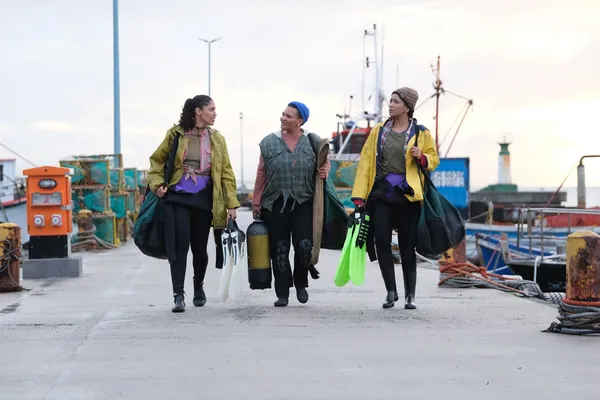 |
| The Umbrella Men: Escape From Robben Island |
In the first part of my interview with Interview with John Barker, Bronté Snell and Shamilla Miller about The Umbrella Men: Escape From Robben Island, which screened as part of the 2023 Toronto International Film Festival, we discussed character development, bringing the female characters to the fore and doing scuba diving stunts in open water in one of the world's most popular places for great white sharks to hang out. It's a sequel which involves Shamilla and Bronté's characters concocting a daring scheme to spring the male members of their family from jail on a reopened Robben Island You don't need to have seen the first one to follow it, but the idea to explain the events of that film – and keep viewers from losing track in this one – by using a Greek-style chorus came about due to the success of the town crier device in the first one, John explains.
“We felt like we needed to not do all the same things we've done in one. I thought that the Greek chorus have also been a very interesting way of breaking the fourth wall and telling the story through their their singing.”
A lot of crew members who worked on the original returned for this. “A lot of the camaraderie that we built up from the first movie definitely got carried over,” says Shamilla. “I think the few key people that were new on set just locked into that family feeling and were caught up in all of the joy anyway.”
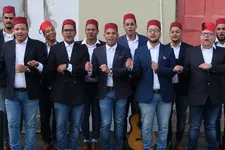 |
| The chorus |
The success of the first film meant that there was a bit more money available for this one, says John, and he laughs. “Not enough to justify the genre of film where you leave actors underwater for a couple of days in the ocean, and break into a prison. So again, it felt like we were our own worst enemies. I think we pulled it off but not having to deal with major compromises all the time and challenges would be great I mean. Like we always joke, our budget is like the exact the catering budget for Ocean's Eleven.”
“We shot for one week extra, but I still think it was tough,” says Shamilla. “I don't think people overseas realise the short span that all movies are expected to shoot in here.”
We discuss the use of Robben Island in the film, and the weight of its brutal history.
“It's a constant reminder,” John says. “As you can see, it's right here in the Bay. You always get a feeling when you look at that. We first did some research. We went onto Robben Island and looked back at Cape Town, and there's this really weird, eerie vibe about the island because of what went on there, the pain of what people were going through. And yet there is this juxtaposition of this beautiful, beautiful, internationally renowned city, Cape Town, which is just across the water.
“If you don't know about the tides, you can look at it and go, ‘I could swim that, I could make that.’ I think was the worst thing for the prisoners, that most of them were going ‘We could do that’ – but, you know, the chances are you're going to die.
“We really tried to get to shoot on island, but unfortunately, because of the nature of what we were trying to shoot, we were shooting in the prison where the ANC were incarcerated for so many years. And because we were using Mandela’s cell...and the quarry was particularly tricky, because in the story, we have the guys escape and run across the quarry. But the ANC worked every single day in that quarry, you know, breaking rocks, that kind of work. We knew it was going to be tricky for the ANC to give us permission to shoot it. The Heritage groups also were very worried about birds, and about our footprint on the island.
“In the end they were like, ‘We just can't allow you guys to shoot there’ – which is completely understandable. But then also we would have spent so much money on the island and the people on the island would have benefited from us being there. So while we understand the nature of our film, and it was a comedy, possibly too much tongue in cheek for something that a lot of the country see as being such a serious past – there's no getting around it – we were never disrespectful. We weren't trying to take anything away from what the ANC went through.”
He hoped to use the film as a way of raising awareness in the younger generation about what Nelson Mandela and other ANC members went through, he says.
“Everyone in that in our crew, the make-up of our crew and the make-up of our producers, mostly predominantly black producers, you know, there's no way they would have been involved with a project that was belittling the ANC and what they went through, and we tried to get that across. But we haven't completely understood why they did. At first, it was crushing when we heard we weren't going to be able to shoot in Robben Island, because I could see this weird eerie vibe about it and aesthetic is completely unlike anywhere else, so we were worried that we wouldn't capture that. But we I think we did a great job. The art department’s Sumaya Wicomb is a fantastically talented production designer and her team are just incredible. They made it feel like the Robben Island.”
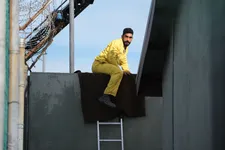 |
| Making the escape |
The other really striking location in the film, which many viewers won’t expect in the vicinity of Cape Town, is the sand dunes.
“Those sand dunes are actually only 45 minutes from the centre of Cape Town,” says John. “I wasn’t actually aware that there were dunes so close, but Bronté had actually shot an entire film, called Atlantis, out in those dunes, so she knew more about it. I was also quite ignorant of the fact that sand dunes move. And so we went and did a recce at the dunes and we found this beautiful dune that didn't have any vegetation. We were like, ‘Fantastic. That's our one.’ Motheo [Moeng, the cinematographer] was like, ‘Okay, the sun's going to set there at this time, and we'll be there. We'll shoot the scene and it’ll be beautiful.’ And four weeks later, we came back and the entire dune it disappeared. It shifted to someone else. I just wasn't aware that the sand moved that much.”
“I can't wait to see that part,” says Bronté. “We actually didn't shoot that much there on the Atlantis movie, they did like one or two shots, but it's beautiful. People like shooting there. It's not very big so you have to just make use of the land, but it's a great location.”
They were also happy to go back to the Bo-Kaap.
“I wanted to use the Bo-Kaap as much as possible because we got such good feedback from people there after the first film,” says John. “Often commercials are shot in Cape Town and they shoot in the Bo-Kaap and you see it for about five seconds, whereas our film is set in the community, the Goema Club is set in the Bo Kaap. We wanted to set a lot of scenes there and because the guys were on Robben Island, it just made sense for the girls to be there in the community. And the chase scenes are all there.” He points to the window beside him. “I'm actually looking out here in Cape Town on the Bo-Kaap and the city runs right up to that suburb, so for the guys to do their chase scene there made complete sense.”
“I love shooting in the Bo-Kaap,” says Shamilla. “You literally can feel the sense of community when you walk in there. Using that and Keisha being new to this family environment and accepted into this community, all of that comes through. I love it.”
“I feel like that part of town, the Bo-Kaap, is like another character,” says Bronté . When we’re there, it feels like, ‘Okay, we're shooting the Umbrella Men,’ you know? Because we shot at so many different locations. It's amazing that we could make use of Cape Town like that. It's just so many different areas, there's a different look and a different feeling, a different vibe. But when it comes to the Bo-Kaap, it grounds us. This is what we're all about. This is where the Goema is and this is home, you know? Every time we’re there, we never know what we're going to get, because Cape Town being Cape Town, there’s always something happening. You'll see people selling stuff on the side of the road, you'll see the aunties that live there. It's always busy and colourful. There's never a dull moment there.”
What did the Bo-Kaap locals actually say about the first film?
“They loved it,” says John. “That was one of the big advantages of us screening the film there. There's a school in Bo-Kaap. We had our first première at the Labia Theatre, and then the second was screened at the school. It was such a good evening. All the kids from the community came to watch the film and it was fantastic. Every second house had them screaming ‘Aaah! There’s our house!’ To see everybody respond like that is so cool. So we’re planning another one of those screenings for 2, and I think there's actually more Bo-Kaap in 2 than there was in 1, so we’re hoping to get the same kind of reception.
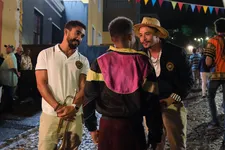 |
| Party time in the Bo-Kaap |
“The timing was bad on this because we got a whole lot of delays with our funders, and eventually got pushed into the month of Ramadan. So our entire schedule fell over that month. And over Ramadan, obviously, because of the prayers and because of the restrictions on movements in the community, we weren't allowed to shoot any singing or any performances. So it was just the worst possible time. And yet, even in Ramadan, the Muslim community were fantastic, letting us shoot. The only thing we couldn't do was was to sing. We were allowed to do all the action scenes as long as we were respectful of prayer, etc.”
In hindsight, Shamilla’s favourite part of the job was shooting some of the action scenes, she says.
“The day that we were shooting the part when Mila hits the guard over the head, for some reason like that day just stands out. There was just so much action. It was me and Bronté in the morning and then the boys came over afterwards and we were just like, I don't know there was something about that day that I really, really loved.”
“I really loved when we were scuba diving,” says Bronté . “That was fun. And there was a day when we were all on set, all doing stunts but also getting to hang out at the same time. But there were moments when we were at a specific location and we were going to shoot this scene and half of it was Shamilla and Bronté and a half of it was Jacques and Keenan. And we just had this moment of ‘Okay, now the A team is up!’ Which was the girls, obviously. And then we got a shot which was just amazing. Then the boys were up and they were like, ‘The A team is actually going to go now!’”
“There was so much rivalry,” recalls Shamilla, laughing, and she turns to John. “I’m sure you told us we were the A team and I’m sure you told the boys they were the A team.”
“Oh my gosh. John is just terrible,” says Bronté as he fails to deny it.
“No, no no,” he protests. “There is no question that you guys completely kicked the guys’ arses and you were the real A-team. Let's start with the water. You were in the water for longer than they were in the water.”
“This is being recorded,” Shamilla reminds him.
Keen to stay on their good side, John tells me about one of their toughest shooting days.
“We went up the coast because we had to go to shoot in the cave, when they go into the cave. And we had a really rough shooter because everyone got seasick. Matheo went out on the water with the guys on the boat, and he started getting sick on the way out there. Him and a couple of the extra started throwing up on the boat. He was green, he was so sick, and he had to keep shooting and the boat just kept doing this” – he makes a strong rocking motion with his hands – “the whole time. It was so crazy. Anyway, up at the caves it was really tough. It was hot in there and the girls were all in their wetsuits, and they weren't in the water because there was no real good water in that cave. You must have been so hot in your wetsuits,” he says sympathetically.
“I was not having a good time that day,” Shamilla remembers.
“It was fun, but it was challenging,” he concludes
Despite the challenges, they are all up for doing it again.
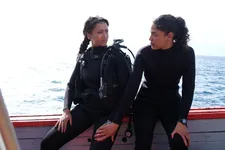 |
| Bronté Snell and Shamilla Miller in The Umbrella Men: Escape From Robben Island |
“We want to make all the Umbrella Men films,” says Shamilla.
“Definitely a third one,” says Bronté . “We can’t leave it hanging at two.”
“I think we should round it out with a third one at least. John, you just have to get the script and convince the producers that it's a go, and then we’ll be there,” Shamilla adds.
“I think a lot of it has to do with how well the sequel is received, and the fact that we got into Toronto a second year – people are amazed we are actually back in Toronto, it really is beautiful to be back, and it means a lot that means that the film is working,” he responds. “It's a really objective view for them to select this film. They felt no obligation to us whatsoever. So it's no longer even just an emotional element to talk about doing a third one. It just it kind of makes sense. It's all working, so why not do it? Let's hope somebody picks up the film and there's a big deal done and Joel and the producers are all happy because you know, that's key for us making the third one in space.”





















